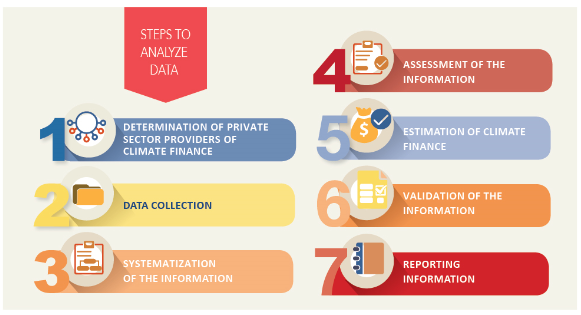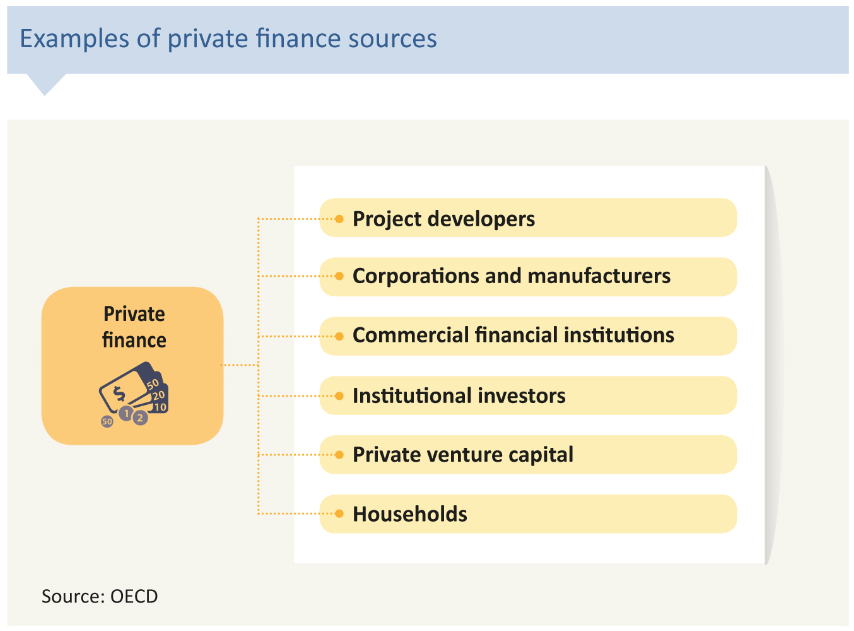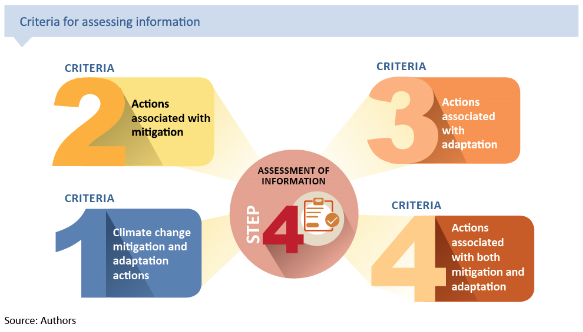This module reports information of climate finance coming from private sources and/or public-private-partnerships in Colombia. Private climate finance providers include both for-profit (e.g. corporations) and non-profit organizations (e.g. private foundations). The module helps increase understanding of the nature of the private financial flows directed to climate change mitigation and adaptation actions.
The module presents information in a variety of forms:
Maps that georeference climate finance information
Summaries of project information
Graphics and tables that analyze data according to a number of variables
Infographics with aggregate information
Users of the platform of the Climate Finance MRV System can also download the entire database of private finance that has been uploaded in the platform.[IM5]
Steps to estimate private finance

Step 1. Determination of private sector providers of climate finance
Private climate finance comes from a wide range of non-governmental actors; from large companies to individual households. Although it is challenging to determine all the private sector providers of climate finance in Colombia, the figure below shows some types of private sector actors that can be included in the analysis.

Step 2. Data collection
Information on finance from private sector actors is found using various sources including:
Existing public databases
Databases of firms
Interviews with staff of private climate finance providers
Below, an indicative list of activities related to climate change that is used to collect information of finance invested. This is the same categories as for international and domestic public finance.

Step 3. Systematization of the information
Once the relevant information is compiled, it is reviewed and organized to ensure it is consistent and comparable. The private finance information was organized by: name of the action, type of action, sector and sub-sector, source of finance, intermediary, implementing entity, recipient, financial instrument, term of financing, amount in Colombian pesos and US dollars, source of information, and use of the resources.
Step 4. Assessment of the information
Once systematized, the information is assessed against four methodological criteria that categorize actions into
actions explicitly addressing climate change mitigation and/or adaptation (criteria 1) and
actions that are associated with mitigation and/or adaptation to climate change (criteria 2-4). The latter consists of actions that generate positive climate change mitigation and adaptation outcomes, regardless of whether the purpose of the action has been explicitly deliberated. The criteria also help categorize actions according to their effect on mitigation, adaptation, or both.

Step 5. Estimation of climate finance
Once the actions and their respective amounts have been identified and classified, the total amount of private finance is estimated.
According to criteria number 1, actions with the explicit purpose of combating climate change are estimated as 100%
climate change actions. Actions that were not explicitly created to combat climate change but nonetheless contribute to the reduction of emissions and vulnerability are counted separately so as to not inflate the numbers for climate actions. However, given the complexity of quantifying the exact share of the resources that contribute to combatting climate change, 100% of the finance has been classified as
actions associated with climate change mitigation and/or adaptation (criteria 2-4).
Step 6. Validation of the information
In cases of doubt about the accuracy of the data, a validation process provided more details. Validation was performed by confirming the figures with private sector climate finance providers and/or recipients/implementing entities.
Step 7. Reporting information
Once the estimation of climate finance is complete and validated, the next step is the preparation of reports that present the various dimensions of private climate finance information in a clear and understandable way for a variety of audiences.
Reports can present information about the following aspects:
Use: mitigation, adaptation, or both.
Methodological criteria: actions tagged as climate change or as actions associated with climate change
Sector
Source of private climate finance
Type of financial instrument
Recipient